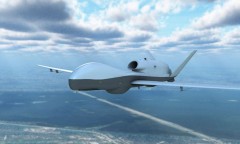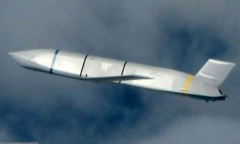By Arthur Dominic J. Villasanta , | April 09, 2017

Two U.S. Navy F/A-18E Super Hornets on combat patrol.
The U.S. Navy will equip its fleet of Boeing F/A-18E/F Super Hornet carrier-based multi-role fighters with "counter-stealth sensors" that can detect and attack enemy stealth fighters such as Russia's Sukhoi T-50 and China's Shenyang J-20.
The long-range, air-to-air counter-stealth sensor called Infrared Search & Track (IRST) can detect stealth aircraft by the heat of their engines, without relying on radar. This capability upgrade is part of the navy's plan to keep the fourth-generation Super Hornet flying into the 2040s.
Like Us on Facebook
"Talk about complimentary capabilities, that's something that Super Hornet brings to the carrier that nobody else has," said Dan Gillian, manager of F/A-18 and EA-18 programs at the Boeing Company.
IRST will come with Block III upgrades to the Super Hornet. Block III upgrades will give Super Hornets the latest datalinks, cockpit displays and IRST.
Block III planes will also have built-in fuel tanks so upgraded Super Hornets and Lockheed Martin F-35 Joint Strike Fighters will have almost comparable ranges.
These "conformal fuel tanks" are more aerodynamic than traditional drop tanks, making them not only more fuel-efficient but also more stealthy. These shoulder-mounted fuel tanks capable of carrying 3,500 lbs. of gas will increase the aircraft's range by 120 nautical miles.
Boeing also plans to improve the Super Hornet's stealth technology.
"We think we do a little bit to the airplane to improve its stealth performance -- very simple, very low cost things we can do," said Gillian.
The navy intends to rebuild hundreds of its Super Hornets to extend their service life from 6,000 to 9,000 flight hours.
There are three efforts to assist the navy in making its Super Hornets and the E/A-18 Growler electronic-attack fleets more potent in current and future missions: increased production; a potential maintenance program called service life modification and Block III upgrades to upgrade aircraft technology such as the new anti-stealth sensor.
-
Use of Coronavirus Pandemic Drones Raises Privacy Concerns: Drones Spread Fear, Local Officials Say

-
Coronavirus Hampers The Delivery Of Lockheed Martin F-35 Stealth Fighters For 2020

-
Instagram Speeds Up Plans to Add Account Memorialization Feature Due to COVID-19 Deaths

-
NASA: Perseverance Plans to Bring 'Mars Rock' to Earth in 2031

-
600 Dead And 3,000 In The Hospital as Iranians Believed Drinking High-Concentrations of Alcohol Can Cure The Coronavirus

-
600 Dead And 3,000 In The Hospital as Iranians Believed Drinking High-Concentrations of Alcohol Can Cure The Coronavirus

-
COVID-19: Doctors, Nurses Use Virtual Reality to Learn New Skills in Treating Coronavirus Patients










